How To Develop A Food Delivery App: Step-by-Step Process Explained
by Sachleen Singh valueappzQuick Summary: Have you ever thought of building a food delivery app and got stuck in the middle? Was it because of a lack of planning or market understanding? Whatever the reason, our guide will give you a complete insight into what goes into making a food delivery app.
The industry of food businesses is facing rapid change. Everything from fast food to healthy meals has gone online. Customers prefer ordering food online rather than spending time in the kitchen.
Therefore, creating a successful food delivery app acts as the best solution for them to fulfill their food cravings. These food-ordering apps are largely focused on convenience and customer experience. Users can quickly search for their favorite food, avail of special deals, and get food delivered from a local restaurant.
For instance, the best food delivery service, like DoorDash, provides features like customization, a wide range of food options, discovering local restaurants, and much more for a smooth online food delivery experience.
If you’re thinking of starting a food delivery venture, you need to take a few key steps to get things off the ground. One of the most important is building a solid business roadmap that includes everything from market research and customer analysis to finalizing your business model and deciding on the features and customizations you’ll need to succeed. And, at last the most crucial step is choosing the best food delivery app development company to help bring your vision to life.
So, let’s dive in and explore the exciting world of launching a food delivery app startup, starting with a deep dive into customer behavior and market demand.
Changing Customer Demand and The Market
On demand food delivery apps are not a decade-old concept; instead, the first online food ordering service started in 1995, known as Worldwide Waiter (now known as waiter.com). Since then, this market has seen an uphill in its growth.
But what makes the best food delivery apps attractive and addictive for users?
The first reason, of course, would be the convenience, but other factors like discounts, unlimited options, easy payments, etc., are also responsible for its growth. Such features have made food apps so addictive that users now mostly prefer ordering food online rather than paying a visit to the restaurant.
The food delivery app industry is projected to reach $320 billion by 2029. Further, 60% of restaurant owners believe that offering food delivery has added great sales to their business.
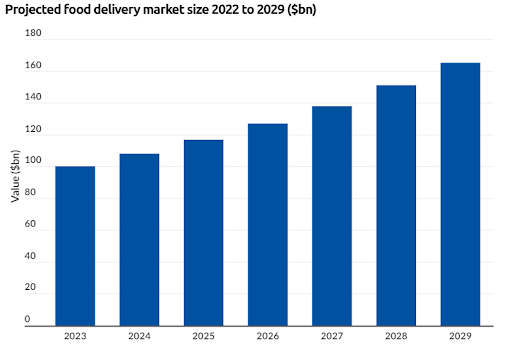
Source: BusinessOfApps
Types of On Demand Food Delivery Apps
Models of food delivery apps can be divided into two based on the number of restaurants they provide. These include restaurant-to-consumer delivery and platform-to-consumer delivery.
1. Restaurant-to-consumer Delivery
Such a model is used by restaurants that provide a digital version of their restaurants. It aims at providing food to the consumers from a particular restaurant through their application.
One of the best examples of this is Domino’s. Though Domino’s is available on other platforms like UberEats and more, it also has its own food delivery app, where customers can directly place an order and receive it straight from Domino’s (hence, not including any third party).
2. Platform-to-consumer Delivery
The Aggregator model has already acquired the food delivery market by providing services at the convenience of consumers. Platform-to-consumer delivery apps bring multiple local restaurants on one platform, where they can place their menus, discounts, and offers. Furthermore, the users can search for restaurants, place orders, and get them delivered quickly.
The best examples of food delivery services are UberEats, DoorDash, and Grubhub, which have millions of users on their respective applications. The aggregator model gives a variety of options to choose from, making it lovable among the audience.
The industry of food businesses is facing rapid change. Everything from fast food to healthy meals has gone online. Customers prefer ordering food online rather than spending time in the kitchen.
To learn more about how Uber Eats generates revenue, check out this insightful blog post, where we explained the Uber Eats Business Model.
Therefore, mobile apps act as the best solution for them to fulfill their food cravings. These food-ordering apps are largely focused on convenience and customer experience. Users can quickly search for their favorite food, avail of special deals, and get food delivered from a local restaurant.
How Much Does Food Delivery App Development Cost?
Estimating the exact amount for food delivery apps can be difficult as it can only be decided after considering factors like the complexity of the app, maintenance, app platform, software and technology required, and the team you will hire to develop the app.
The average food delivery app development cost can range between $15,000 to $60,000. But this can further vary depending on the factors mentioned above. Hence, choosing a food delivery app development company that fits your budget requirements is extremely important.
But why does the cost vary so much? And what other factors affect the development cost? The answer is app features. To build a competitive food delivery app, you need basic and advanced features for all four apps—customer, service provider, admin, and delivery agents.
The section below mentions the must-have features for a successful food delivery app.
Essential Features of a Food Delivery App
What makes an app great? Or what kind of app retains its users? It is all the game of kinds of features that an application provides. Here, we will discuss the essential elements from the basis of consumers, admin, and courier.
1. Features of Customer App
Once your app comes into the market to the point where it gets valuable customers, engaging and retaining them is vital. The following features can help with it.
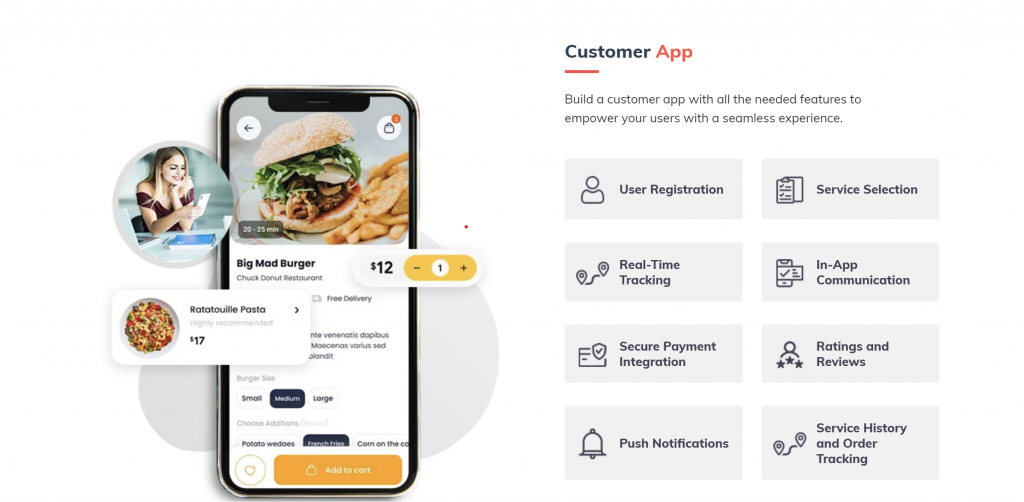
1.1. Easy User Registration
Registration is the first step that users will take. So, it should be simple and quick. It can be either done through email and password or via social media like Google, Twitter, Instagram, and more. Whatever the app contains, the data should be protected, so the user has a sense of security.
1.2. User Profile
Now that the users have registered, they would want to manage their profiles. Their profile will include personal information, favorite restaurants, order history, saved payment options, food preferences, and much more that can provide quick access to them.
1.3. Geo-Location
Setting the exact location should be simplified. It can be done via auto-detecting or filling in the details manually. The location can be further categorized into the home, work, or other categories.
Their exact location will also help users to find nearby restaurants. Additionally, it will also connect the users with local restaurants.
1.4. Restaurant/Dish Search
Search option directly affects user retention. The easier it is for users to find a restaurant or dish, the better the chances of them coming back. To make the feature more user-friendly, you can add certain filters like location, food category, etc.
They should be able to locate multiple restaurants quickly.
1.5. Placing an Order
Making an order should be totally easy for the user. They should be able to add items to the cart, remove items, or add more if needed. The total cost, including the delivery fee, should also be available in the cart with other information regarding tax, service fees, and more. Further, a feature like pre-order food will be a cherry on top of the cake.
1.6. Quick Payment
Now that the user has placed an order, making payment should not be a problem. They must get multiple payment options like debit or credit card, cash on delivery, UPI, or through other in-built payment methods.
1.7. Real-time Tracking
Real tracking of the order allows users to get instant updates on their food, whether it is in the preparation stage, packing stage or prepared food is on its way, and estimated delivery time so that they can monitor it throughout.
Further, information regarding the delivery driver gives them access to contact the person directly.
1.8. Customizing Orders
People have become conscious about what they eat. A customization option in the application will help in user retention. Restaurants and food delivery providers must adjust to the users’ options. For instance, some may be allergic to a food item, or others may want gluten-free food.
1.9. In-app Messaging
The feature is crucial as it will allow users to contact customer care in case of any problem. An in-app messaging feature will also help them communicate with couriers.
1.10. Rating and Reviews
Consumer feedback is an essential part of the app. They should be able to rate both the food and the delivery. It provides them a space to share positive and negative experiences with others. Also, the admin can use this to enhance their app.
1.11. Push Notifications
Through push notifications, users can get information regarding discounts, coupons, special offers, and estimated delivery time, ensuring that they get every important data. It is also used for providing every-minute details on their current order.
2. Features of Restaurant App
Restaurants are another part of this three-sided business model. Hence, each restaurant should be able to display menus, provide information, and quickly get in touch with its customers. Its features should include the following:
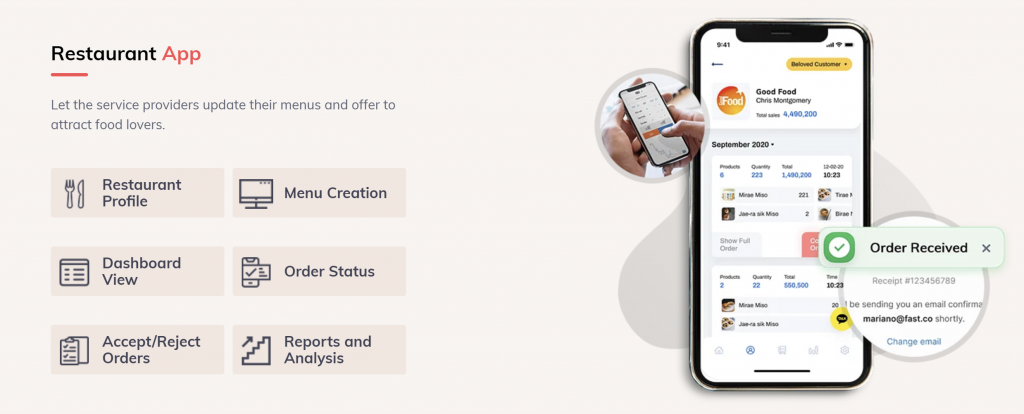
2.1. Admin Dashboard
It is the primary feature, ensuring access to multiple management tools like controlling delivery orders, public data, and other content.
2.2. Registration
This feature will help a restaurant create a representative account that will be displayed on the search. Restaurants usually undergo authorization with login (company name) and password.
2.3. Content Management
Content management features will let the restaurant edit public information like restaurant name, working hours, address, dish prices, delivery rates, menu, photos, videos, and much more.
2.4. Order Management
This function will help restaurants track the order in real-time. It can contain information about order status, whether it’s accepted, ready, delayed, or canceled.
2.5. Receiving Payments
As restaurants receive the payment after placing the order, a payment feature is essential for a transaction fairness guarantee.
2.6. Customer Support
Restaurants should be able to track their customer’s concerns via live chat. They should quickly receive any questions from buyers and answer them instantly.
3. Features of Delivery Partner App
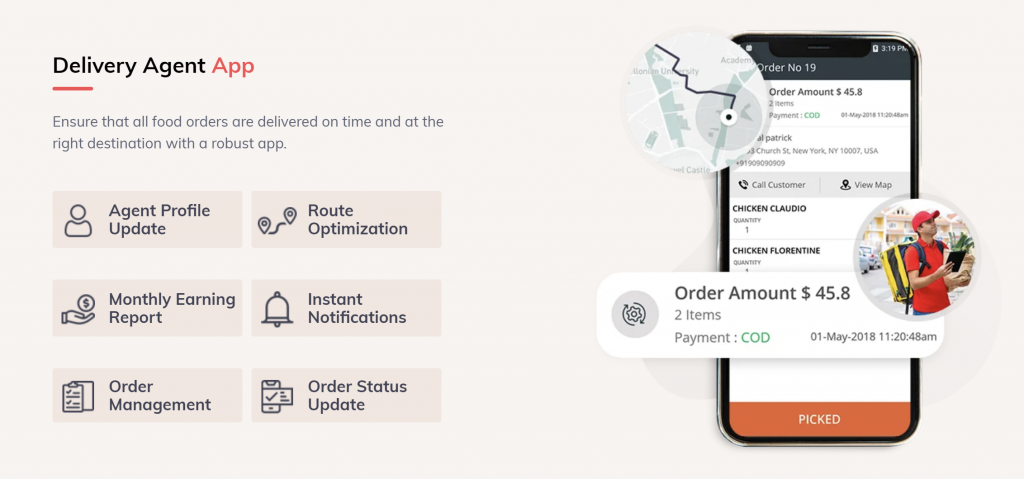
Food delivery app development for delivery partners is equally important as they will use it on the go. It must include all features that make food delivery an easy process and where they can contact in an emergency.
3.1. Registration
As much as it is necessary for customers and restaurants to make a profile, so is it for the delivery people. It can be done either by email and password or via social media accounts.
3.2. Profile Management
The profile usually contains information about name, working hours, photo, and others. The feature should be easy to use to make any changes hassle-free.
3.3. Order Management
Such a feature will help delivery workers view, accept, or reject orders.
3.4. GPS Support
It is imperative to ensure that the driver delivers food to the correct address without the delivery person getting lost in the way.
3.5. Contact Restaurant/Customer
The delivery person should be able to contact a consumer or restaurant if needed while delivering food.
4. Features of Admin Dashboard
The admin app gives the admin complete control over the food delivery operations. From managing orders to handling deliveries, restaurants, and more, a robust app can help the admin manage everything seamlessly.
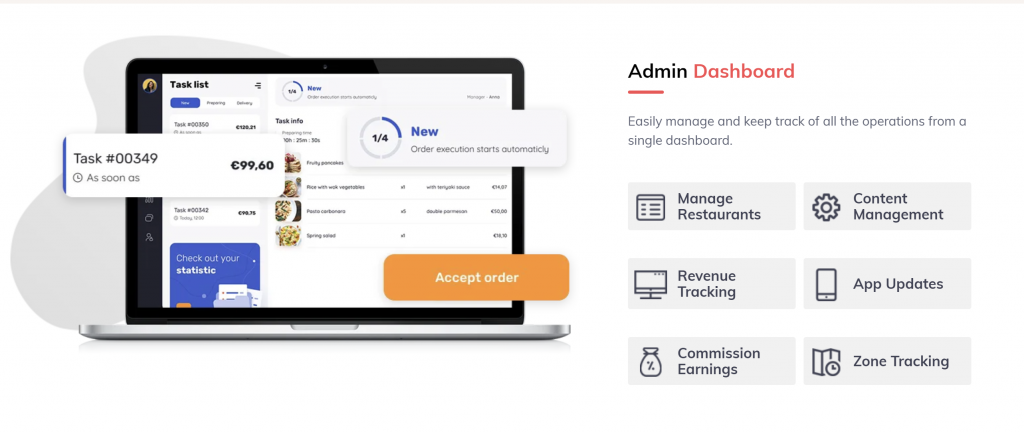
4.2 Order Management
This particular feature is essential for the admin to access and manage all incoming orders through one app. It should include viewing order details, tracking status, and updating it timely.
4.3 User Management
The admin should also be able to manage user accounts, including customers, delivery drivers, and restaurant partners.
4.4 Restaurant Management
The admin app must also give the power to manage restaurant partners through the app by verifying their information, setting commission rates, and assisting with menu setup.
4.5 Analytics and Reports
The analytics and reports are another vital feature to include in the admin app. They should
Created on Oct 25th 2023 01:54. Viewed 96 times.
Sponsor Ads
Comments





